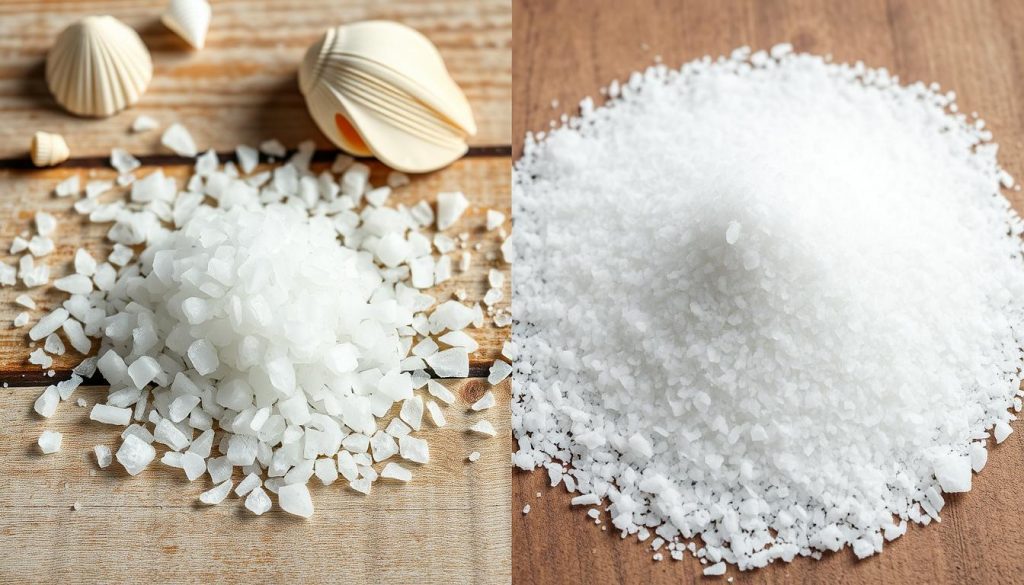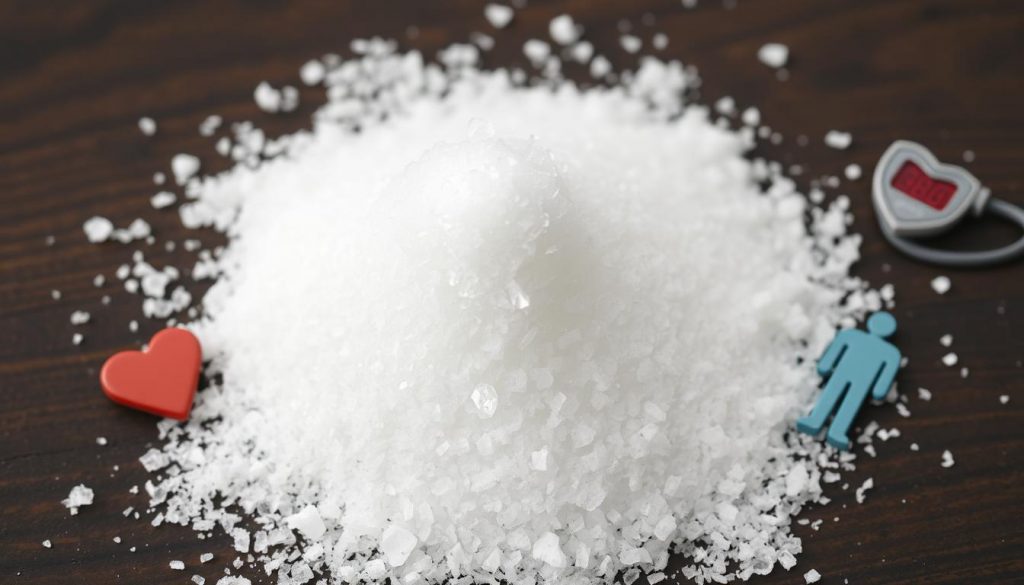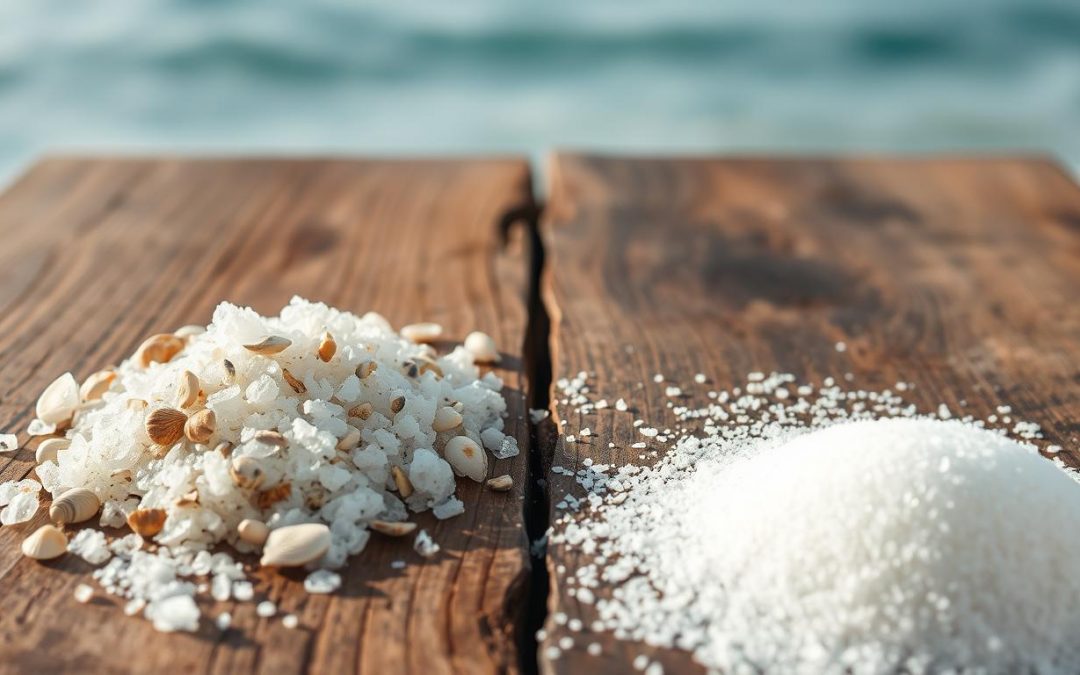When it comes to salt, we often wonder: what’s the difference between sea salt and table salt? Which one is healthier? We’ll look into the nutritional values, health benefits, and uses of both. You’ll learn about the benefits of sea salt and the drawbacks of table salt.
Did you know 61% of people think sea salt is lower in sodium than table salt? But, both have about 40% sodium1. A teaspoon of table salt has around 2,300 milligrams of sodium1. Table salt and sea salt both have about 40% sodium by weight2.
Table of Contents
Key Takeaways
- We will explore the differences between sea salt and table salt, including their nutritional values and health benefits.
- Sea salt and table salt have different processing methods, mineral content, and flavor profiles.
- The American Heart Association suggests a more stringent sodium limit of 1,500 milligrams per day2.
- Sea salt prices start at more than twice the price of table salt2.
- We will discuss the sea salt benefits and table salt disadvantages, helping you make an informed decision about which one is better for you.
What is Sea Salt?
Sea salt is made by evaporating seawater. It’s usually not processed much, keeping its natural sea salt definition and taste3. This method keeps its minerals and flavor, making it a favorite among chefs and health fans. The sea salt extraction is simple, using shallow pools to evaporate seawater.
There are many sea salt varieties, like Himalayan pink salt, fleur de sel, and Maldon sea salt. Each has its own taste and texture4. These salts are often picked by hand and come in different forms, like fine grains and crystals. The sea salt benefits for health are big, as it has minerals like magnesium, potassium, and calcium5.
Here’s a quick look at some well-known sea salt types:
- Himalayan pink salt: Known for its pink color and mineral-rich content
- Fleur de sel: A type of sea salt harvested by hand, known for its delicate flavor and high mineral content
- Maldon sea salt: A type of sea salt produced in England, known for its flaky texture and mild flavor
What is Table Salt?
Table salt, also known as sodium chloride, is a common salt used in cooking. It’s a crystalline mineral that adds flavor to food. Some brands add iodine to prevent iodine deficiency5. It’s made by mining and refining, making it cheaper than sea salt4.
Table salt has many uses. It’s used in baked goods and savory meals. It’s also a seasoning to boost flavor. For tips on seasoning, check out cooking tips and reviews. It’s also used to preserve food, stopping bacteria and other microorganisms6.
Here’s a quick summary of table salt:
- Table salt is a type of salt used in cooking and as a seasoning
- It is typically mined from underground deposits and refined
- It is often fortified with iodine to prevent iodine deficiency
- It is commonly used in a variety of dishes and as a preservative
Nutritional Differences Between Sea Salt and Table Salt
When comparing sea salt vs. table salt nutrition, both have similar sodium levels. Yet, they differ in minerals and additives. Sea salt keeps natural minerals from seawater like magnesium, potassium, and calcium. These can add health benefits and flavor to food7.
Table salt, on the other hand, is often fortified with iodine for thyroid health. It may also have additives and anti-caking agents that can change its nutritional value and taste7.
Sea salt and table salt have different mineral contents. Sea salt keeps minerals like calcium, iron, and magnesium because it’s processed less7. Table salt, being refined, might have additives like anti-caking agents. This can impact its nutritional value. For more on the differences, check out this resource about sea salt minerals and table salt additives.
| Type of Salt | Sodium Content | Mineral Content | Additives |
|---|---|---|---|
| Sea Salt | Approximately 2,000 mg per teaspoon6 | Retains trace minerals like magnesium, potassium, and calcium7 | None or minimal7 |
| Table Salt | Approximately 2,300 mg per teaspoon6 | May be fortified with iodine7 | May contain additives and anti-caking agents7 |
Taste Comparison: Sea Salt vs. Table Salt
Sea salt and table salt taste differently. Sea salt is coarser and has a more complex flavor, loved by chefs and food lovers4. It has minerals that table salt often lacks. Table salt, on the other hand, is neutral and good for baked goods and recipes needing a light salt taste4.
Sea salt adds depth to dishes, while table salt dissolves quickly and evenly. Your choice depends on your taste and the dish. For more on salts, check out cooking tips and reviews.
Flavor Profiles
Sea salt and table salt taste unique. Sea salt is more nuanced and complex4. Its flavor changes based on its source, sometimes tasting sweet or mineral-rich. Table salt is uniform and used as a neutral seasoning.

Best Uses in Cooking
Use sea salt as a finishing salt, adding it just before serving5. Table salt is better for cooking and baking because it dissolves quickly. Knowing the taste difference helps cooks choose the right salt for their dishes5.
| Salt Type | Flavor Profile | Best Uses |
|---|---|---|
| Sea Salt | Complex, nuanced | Finishing salt, adding depth to dishes |
| Table Salt | Neutral, uniform | Cooking, baking, where quick dissolution is beneficial |
Health Benefits of Sea Salt
Sea salt is packed with health benefits, thanks to its rich mineral content. It’s good for your skin and digestion. The sea salt health benefits come from its minerals. These can help balance fluids, support bones, and reduce inflammation8. Adding sea salt to your meals can bring these benefits into your life.
Sea salt is full of minerals like magnesium, potassium, and calcium. These minerals offer extra health perks and flavor to your food. They help with fluid balance, bone health, and inflammation reduction8. Sea salt also benefits your skin by reducing inflammation and improving hydration8.
Sea salt can also help with digestion. It boosts hydrochloric acid production, easing indigestion, bloating, and heartburn8. With its mineral content and benefits for skin and digestion, sea salt is a great choice for a healthy diet.
Health Concerns Related to Table Salt
Eating too much table salt can cause high blood pressure, heart disease, and stroke. This is because it has a lot of sodium9. On average, Americans eat about 3,300 mg of sodium every day. Most of this comes from foods that are already processed9. Table salt is often used too much in cooking and as a flavor enhancer.
The sodium in table salt is a big worry. It can increase the risk of heart disease and stroke10. It can also mess with the body’s fluid balance, causing bloating and water retention. It’s important to watch how much table salt we eat and look for other ways to flavor our food.
Some important facts about table salt health concerns include:
- Average sodium intake per day: 3,300 mg9
- Recommended daily intake of sodium: 1,500 mg9
- Sodium content in table salt: approximately 40%9
We need to know the health risks of eating too much table salt and try to eat less sodium10. By choosing better seasonings and cooking methods, we can lower the risks linked to table salt.

Culinary Uses: Which Salt to Choose?
Sea salt is loved for its rich flavor and coarse texture, making it perfect for gourmet cooking11. It’s great for adding depth to dishes. Table salt, on the other hand, is used in everyday recipes like baked goods and soups. It’s chosen for its subtle flavor12.
The type of salt you use can really change how a dish tastes and feels. Sea salt brings out the natural flavors of ingredients. Table salt, with its smaller crystals, needs more precise measuring12. Sea salt is great for seasoning meats, vegetables, and soups. It’s also used as a finishing salt to add texture and flavor11.
Here are some key differences between sea salt and table salt:
- Sea salt has a coarser grain and a more complex flavor profile11
- Table salt is typically iodized and has a smaller crystal size12
- Sea salt is often used as a finishing salt, while table salt is used in cooking and baking11
Sea salt can be pricier than table salt, but it’s worth it for its unique flavor and texture11. Whether you choose sea salt or table salt, knowing their differences helps you pick the right one for your recipe12.
The choice between sea salt and table salt depends on your taste and the dish you’re making11. Understanding each salt’s unique qualities helps you make better choices. This can elevate your cooking to new heights12.
| Salt Type | Flavor Profile | Texture |
|---|---|---|
| Sea Salt | Complex, nuanced | Coarse, crunchy |
| Table Salt | Subtle, salty | Fine, powdery |
Environmental Impact of Sea Salt Harvesting
Harvesting sea salt can harm marine ecosystems, like destroying habitats and disturbing marine life13. But, many sea salt makers are changing their ways. They use green methods and cut down on waste. By picking sustainable sea salt, we help lessen the harm and support good practices.
When looking at sea salt harvesting’s environmental effects, consider these points:
- Energy use: Sea salt making needs less energy than table salt, which is mined and processed14.
- Water use: It takes a lot of seawater, affecting local ecosystems13.
- Waste reduction: Eco-friendly sea salt makers aim to cut waste and lessen their environmental mark13.
The environmental impact of sea salt harvesting is complex. It depends on the method, energy use, and waste reduction14. By choosing sustainable sea salt and backing responsible makers, we can help. This promotes greener practices.
| Harvesting Method | Energy Consumption | Water Usage | Waste Reduction |
|---|---|---|---|
| Sea Salt Harvesting | Low | High | Medium |
| Table Salt Production | High | Low | Low |
Cost Considerations: Sea Salt vs. Table Salt
Sea salt is pricier than table salt because of its higher quality and complex harvesting process15. The cost of sea salt can range from 1.5 to 5 times more than table salt16. For instance, a 17.6-ounce jar of Jacobsen pure flake sea salt costs about $5515. In contrast, a 26-ounce container of iodized Morton salt is under $115.
The sea salt cost is often seen as worth it for its unique flavor and health benefits. On the other hand, table salt price is lower, making it a budget-friendly choice. Yet, the sea salt value should be considered, as it might be worth the extra cost for some17.
Here’s a look at the prices of different salts:
| Salt Type | Price per Ounce |
|---|---|
| Morton iodized salt | $0.03 |
| Jacobsen pure flake sea salt | $3.13 |
| SaltWorks Mediterranean sea salt | $0.51 |
| 365 Everyday Value sea salt | $0.06 |
The choice between sea salt and table salt depends on personal taste and budget. Sea salt’s unique flavor and health benefits might make it a good investment for some16.
Final Thoughts: Which Salt is Better for You?
The debate between sea salt and table salt comes down to what you like and need18. Sea salt has a unique taste and might offer health benefits like trace minerals19. But, table salt is cheaper and easier to find in most homes19.
Choosing between sea salt and table salt depends on your taste and health goals19. If you want a special flavor or health perks, sea salt might be best19. But, if you’re watching your budget and want something easy to find, table salt is a good choice19.
It’s important to remember to use salt in moderation, no matter which one you pick18. Knowing the differences in taste and health benefits can help you choose the right salt for you19.
FAQ
What is the difference between sea salt and table salt?
What are the health benefits of sea salt?
What are the health concerns with table salt?
How do sea salt and table salt differ in taste and culinary applications?
What is the environmental impact of sea salt harvesting?
How do the costs of sea salt and table salt compare?
Source Links
- Sea Salt vs. Table Salt – https://www.heart.org/en/healthy-living/healthy-eating/eat-smart/sodium/sea-salt-vs-table-salt
- Sea Salt vs. Table Salt: What’s the Difference? – https://www.eatingwell.com/article/7994585/sea-salt-versus-table-salt-whats-the-difference/
- Table salt, kosher salt, sea salt, Himalayan salt. Which one should I buy? – https://www.mcgill.ca/oss/article/health-nutrition-you-asked/table-salt-kosher-salt-sea-salt-himalayan-salt-which-one-should-i-buy
- Kosher Salt vs. Sea Salt vs. Table Salt – https://handletheheat.com/salt-101/
- Sea salt vs. table salt: Differences and health benefits – https://www.medicalnewstoday.com/articles/326519
- Sea Salt: Uses, Benefits, and Downsides – https://www.healthline.com/nutrition/sea-salt-benefits
- Sea Salt vs. Table Salt: What’s the Difference? – https://www.realsimple.com/sea-salt-vs-table-salt-8663104
- 5 Spectacular Benefits Of Adding Sea Salt To Your Diet – https://www.netmeds.com/health-library/post/5-spectacular-benefits-of-adding-sea-salt-to-your-diet?srsltid=AfmBOopF-LJZfL9sK0QgC-ilmNVX00y6-s9eDJWc9hfnoTkfKIEzlvuA
- Salt and Sodium – https://nutritionsource.hsph.harvard.edu/salt-and-sodium/
- The Health Benefits of Using Sea Salt vs. Table Salt – https://www.seasaltsuperstore.com/blogs/what-is-salt/the-health-benefits-of-using-sea-salt-vs-table-salt?srsltid=AfmBOoqv2RN7pQSwQVlrvnp76KVkireIbb0h4W9GVQNjFfRsyNmoa8si
- Table Salt vs. Sea Salt vs. Kosher Salt: What’s the Difference? – https://www.allrecipes.com/article/types-of-salt/
- Should You Use Sea Salt or Table Salt? – https://www.simplyrecipes.com/sea-salt-vs-table-salt-experts-8714591
- Are some kinds of salt better for the planet than others? – https://slate.com/technology/2010/03/are-some-kinds-of-salt-better-for-the-planet-than-others.html
- Is Sea Salt More “Natural” Than Table Salt? – https://www.seasaltsuperstore.com/blogs/what-is-salt/is-sea-salt-more-natural-than-table-salt?srsltid=AfmBOor3xcpVeuBT9JfXNajunniNwk1M0EP6uZYDNK0vu_hMlvuprZKy
- What’s The Difference Between All The Types Of Salt? – https://www.huffpost.com/entry/salt-whats-the-difference_l_5da747aee4b062bdcb1cad48
- Sea Salt vs Table Salt | 8 Key differences in them – https://swayampaak.com/blog/sea-salt-vs-table-salt/
- No title found – https://www.rupahealth.com/post/sea-salt-himalayan-salt-table-salt-health
- Which Type of Salt is Best for You? | Dietitians On Demand Blog – https://dietitiansondemand.com/salt-shake-up-which-type-of-salt-is-best-for-you/
- Table Salt vs Sea Salt Main Differences – https://blog.hollyhammersmith.com/table-salt-vs-sea-salt/

